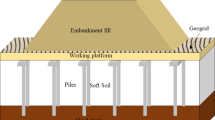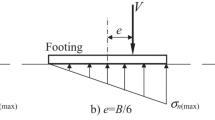Abstract
The present study deals with the slope stability analysis and geotechnical assessment of a part of pilgrimage route to one of the holy shrines of India, i.e. Yamunotri. The route also embraces a proposed site for 204 m high concrete gravity dam across River Yamuna near Lakhwar village with the aim of generation of 300 MW power. Several slide zones were identified and based on the discontinuity orientation, structural features and debris materials, they are recognised as planar, wedge or circular failure types. The morphological dimensions, structural data, orientations and geotechnical parameters of circular failure slides within weathered quartzites, phyllites and shales were evaluated by extensive field work and by laboratory tests for their stability analysis. Internal mechanisms, cohesion and angle of internal friction that resist shear stress in slope materials, obtained from direct shear test are showing minor variation due to relatively consistent grain size distribution and mineralogical composition. General slope is about 40°–43° with sparse vegetation. Materials in and around slide zones are sands with appreciable amount of fines falling in SP–SM category as per Unified Soil Classification System (USCS), except Niste B slide which has clean sands lying in SP group. Factor of safety, computed by requisite parameters of strength, soil and slope properties in circular failure charts, varies from 1.02 to 1.23 in dry conditions while it reduces below unity with increasing saturation, representing stable conditions in dry conditions but with seepage and saturation along the cracks and discontinuities during rainfall make them unstable. Presence of steep slopes, proximity to stream channels and significant weathered and jointed area are causative factors in the route with rainfall and road widening as major triggers initiating the failure.













Similar content being viewed by others

References
Abramson L, Thomas L, Sharma S, Boyce GM (1996) Slope stability and stabilisation methods. Wiley, Hoboken, p 629
Adunoye GO (2014) Fines content and angle of internal friction of a lateritic soil: an experimental study. Am J Eng Res 03(3):16–21
Anbalagan R (1997) Mass wasting types, causes and map** in himalayan region. In: Agarwal DK, Krishna AP, Joshi V, Kumar K, Palni MS (eds) Perspectives of mountain risk engineering in the himalayan region. Gyanodaya Publications, Nainital, pp 33–52
Anbalagan R, Singh B, Chakraborty D, Kohli A (2007) A field manual for landslide investigations. Report submitted to Department of Science and Technology, New Delhi, p 146
Arora KR (2009) Soil mechanics and foundation engineering (Geotechnical Enginnering) Standard Pub and dist New Delhi, p 953
ASTM D2487 (2011) Standard practice for classification of soils for engineering purposes (Unified Soil Classification System), p 12
Bahsan E, Liao H, Ching J, Lee S (2014) Statistics for the calculated safety factors of undrained failure slopes. Eng Geol 172:85–94
Bareither CA, Edil TB, Benson CH, Mickelson DM (2008) Geological and physical factors affecting the friction angle of compacted sands. J Geotech Geoenvironmental Eng 134(10):1476–1489
Bordoni M, Meisina C, Valentino R, Lu N, Bittelli M, Chersich S (2015) Hydrological factors affecting rainfall-induced shallow landslides: from the field monitoring to a simplified slope stability analysis. Eng Geol 193:19–37
Bromhead EN (1992) The stability of slopes, blackie academic and professional. Chapman & Hall, Glasgow
Carrara A, Cardinali M, Detti R, Guzzetti F, Pasqui N, Reichenba P (1991) GIS technique and statistical models in evaluating landslide hazard. Earth Surf process landf 16:427–445
Chung ChF, Fabbri AG (1995) Multivariate regression analysis for landslide hazard zonation. In: Carrara A, Guzzatti F (eds) Geographical information systems in assessing natural hazards. Kluwer Academic Publisher, Dordrecht, pp 107–142
Disaster Management Mitigation Centre, Uttarakhand (2012) Newsletter
Duncan JM, Wright SG (2005) Soil strength and slope stability. JohnWiley, Hoboken, p 309
Eid HT (2014) Stability charts for uniform slopes in soils with nonlinear failure envelopes. Eng Geol 168:38–45
Ermini L, Catani F, Casagli N (2005) Artificial neural networks applied to landslide susceptibility assessment. Geomorphology 66:327–343
Goodman RF (1980) Introductory rock mechanics. Wiley, New York
Gorbushina VK (1997) Effect of landslide processes on construction and operation of hydropower structures. Hydrotech Constr 31(10):629–634
Hammouri NA, Abdallah I, Malkawi Husein, Yamin MA (2008) Stability analysis of slopes using the finite element method and limiting equilibrium approach. Bull Eng Geol Environ 67:471–478
Harp EL, Wells WG II, Sarmiento JG (1990) Pore pressure response during failure in soils. Geol Soc America Bull 102:428–438
Hoek E, Bray JW (1981) Rock slope engineering. Inst. of Mining and Metallurgy, London, p 402
Iverson RM (2000) Landslide triggering by rain infiltration. Water Resour Res 36(7):1897–1910
Jade S, Sarkar S (1993) Statistical models for slope instability classification. Eng Geol 36:91–98
Janbu N (1996) Slope stability evaluation in engineering practice. In: Proceedings seventh international symposium on landslides, Trondheim, Norway, 1, pp 17–34
Krahn J (2003) The 2001 R.M. Hardy Lecture: the limits of limit equilibrium analyses. Can Geotech J 40:643–660
Michalowski RL (2010) Limit analysis and stability charts for 3D slope failures. J Geotech Geoenvironmental Eng 136(4):583–593
Negi RS (1993) Analysis of subsurface exploration data at Lakhwar dam site, Yamuna valley. Ind Min 47(4):305–314
Roopnarine R, Eudoxie G, Opadeyi J (2013) Soil friction angle as an instability factor in landslide susceptibility modeling. J Earth Sci Geotech Eng 3(1):55–71
Seboong Oh, Ning Lu (2015) Slope stability analysis under unsaturated conditions: case studies of rainfall-induced failure of cut slopes. Engineering Geology 184:96–103
Sharma S, Raghuvanshi T, Sahai A (1999) An engineering geological appraisal of the Lakhwar Dam, Garhwal Himalaya, India. Eng Geol 53:381–398
Shen J, Karakus M, Xu C (2013) Chart-based slope stability assessment using the Generalized Hoek-Brown criterion. Int J Rock Mech Min Sci 64:210–219
Sidle RC, Pearce AJ, O'loughlin CL (1985) Hill slope stability and land use. American Geophysical Union, Washington, p 125
Soeters R, Van Westen CJ (1996) Slope stability recognition, analysis and zonation. In: Schuster RL (ed) Landslide investigation and mitigation, Transport Research Board, special Report 247. National research Council, Washington, pp 129–177
Springman SM, Thielen A, Kienzler P, Friedel S (2013) A long-term field study for the investigation of rainfall-induced landslides. Geotechnique 14:1177–1193
Valdiya KS (1980) Geology of Kumaun Lesser Himalaya. Wadia Institute of Himalayan Geology, Dehradun
Van Reeuwijk LP (1993) Procedures for soil analysis, International Soil Reference and Information Center (ISRIC) Technical paper, no.9, ISRIC, pp19
Wieczorek GF (1996) Landslide triggering mechanisms. In: Turner AK, Schuster RL (eds) Landslides: investigation and mitigation, Transportation Research Board Special Report 247. National Research Council, Washington, pp 76–79
Yalcin A (2007) The effects of clay on landslides: a case study. Appl Clay Sci 38:77–85
Yang X-L, Li L, Yin JH (2004) Stability analysis of rock slopes with a modified Hoek-Brown failure criterion. Int J Numer Anal Methods Geomech 28(2):181–190
Zhang J, Huang HW, Juang CH, Li DQ (2013) Extension of Hassan and Wolff method for system reliability analysis of soil slopes. Eng Geol 160:81–88
Zhu DY, Lee CF, Jiang HD (2003) Generalised framework of limit equilibrium methods for slope stability analysis. Geotechnique 53(4):377–395
Zydroń T, Zawisza E (2011) Shear strength investigation of soils of landslide areas. Geologija 53(3):147–155
Acknowledgements
The authors are thankful to Dr. O.P.Kulshreshtha, Principal, DBS (PG) College, Dehradun, for providing necessary facilities and constant encouragements to carry out the above studies. Financial support to D.D. through WOS-A scheme of Department of Science and Technology is gratefully acknowledged.
Author information
Authors and Affiliations
Corresponding author
Rights and permissions
About this article
Cite this article
Dudeja, D., Bhatt, S.P. & Biyani, A.K. Stability assessment of slide zones in Lesser Himalayan part of Yamunotri pilgrimage route, Uttarakhand, India. Environ Earth Sci 76, 54 (2017). https://doi.org/10.1007/s12665-016-6366-y
Received:
Accepted:
Published:
DOI: https://doi.org/10.1007/s12665-016-6366-y



